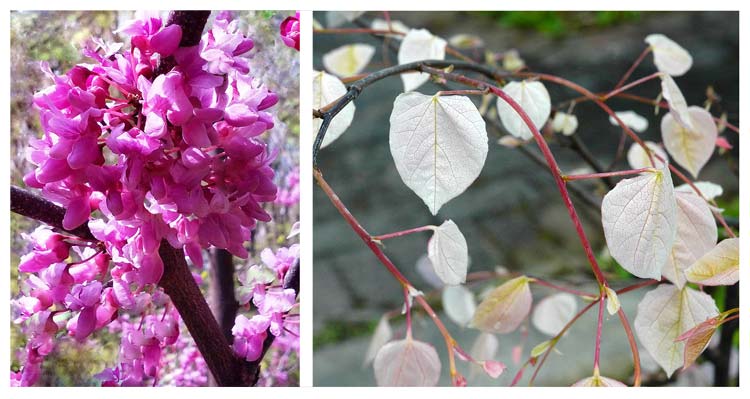Cercis canadensis ‘Carolina Sweetheart’.
One of the many rare and beautiful trees currently on sale at Seamus O’Driscoll’s Garden Centre, situated on the Mill Road, here in Thurles, Co. Tipperary, must surely be the Cercis canadensis ‘Caroline Sweetheart’, also called the Judas Tree or Flowering Judas Eastern Redbud.
With the name ‘Judas Tree’ comes a legend behind its name, going back to earlier Christian folklore. This myth / folklore hereunder surrounds all such Redbud varieties in the same Genus, found in various parts of the Middle East including Judea.

Christian Folklore
The legend states that originally all such trees were not just tall and stately, but also bore broad, strong branches displaying white flowers. In exchange for thirty pieces of silver; one of the 12 disciples, all followers of Jesus, named Judas Iscariot, from the town of Kerioth in south Judea, would eventually betray Jesus to the Sanhedrin in the Garden of Gethsemane. This was simply done by kissing Jesus and addressing him as “Rabbi”; thus revealing his identity to the crowd who had come to arrest him. Judas, on learning later that Jesus was to be crucified, in his shame, hanged himself from supposedly a Redbud tree. The tree itself became so ashamed of the role it had played; vowed that forever more it would not grow its branches strong enough to be used for a hanging. Its wood from then on would remain brittle and its pure white flowers would blush pink, demonstrating visual embarrassment. Thus, the alternate name for Redbud trees became “Judas Trees”; the tree Judas chose for his eventual death.
However, possibly the real truth is that Redbud trees grew throughout Judea and were simply called “Judea’s Trees”, which over time and through word of mouth, verbal accents etc, today have become known as “Judas Trees”.
Just presently shedding its ‘blushing, snapdragon like blossoms’; Cercis canadensis ‘Carolina Sweetheart’, is much sought after in landscaping, especially since its flowers are somewhat unusual, in that they grow from the trunk of the tree, a trait often observed on tropical tree species, and known as “Cauliflory”. For our readers not familiar with the terminology “Cauliflory”, same is a botanical idiom which refers to plants that flower and fruit from their main stems or woody trunks, rather than from new growth; thus aiding pollination from not just flying insects, but also from animals rubbing and climbing.
With flowering complete; typical heart shaped maroon leaves [dark reddish purple or dark brownish red colour taking its name from the French word ‘marron’, or chestnut] will emerge, before becoming green with white margins bearing delightful shades of pink red and purple.
Overall, Cercis canadensis ‘Caroline Sweetheart’, is best described as ‘sheer candy’ to the eyes of any beholder.

Leave a Reply